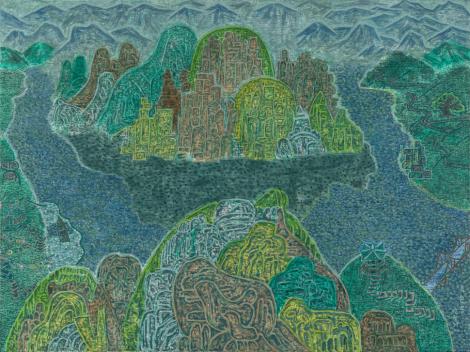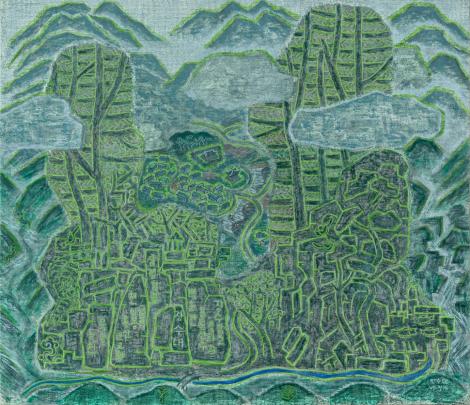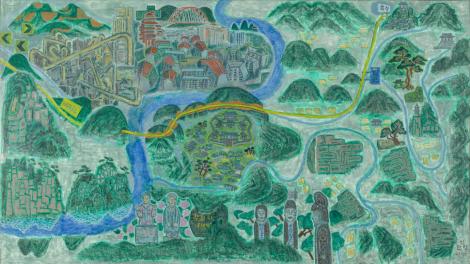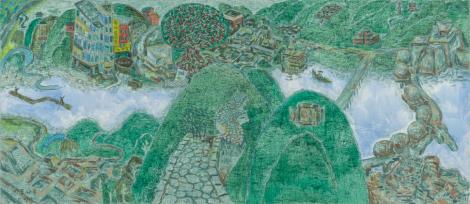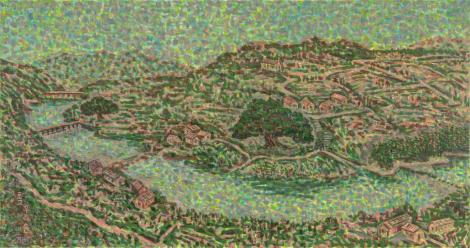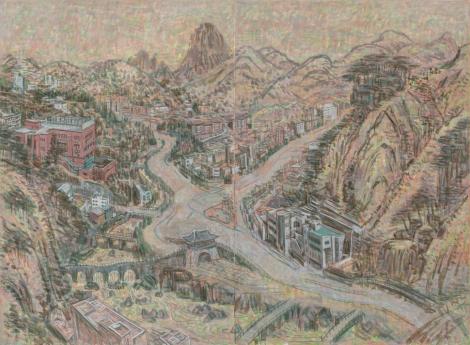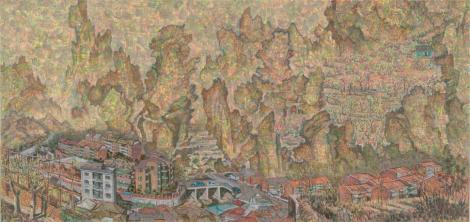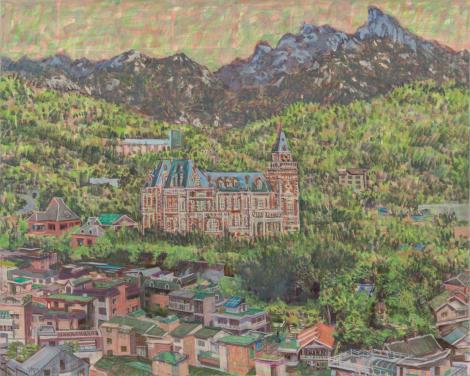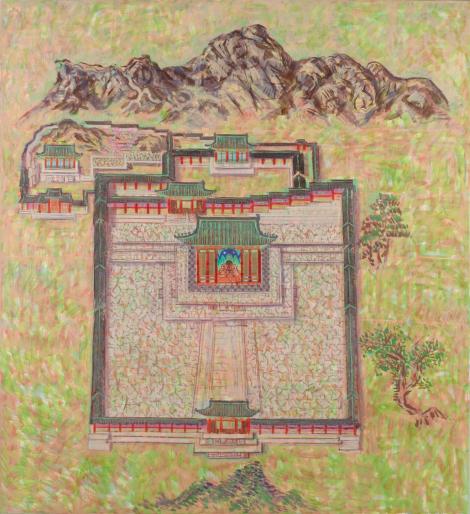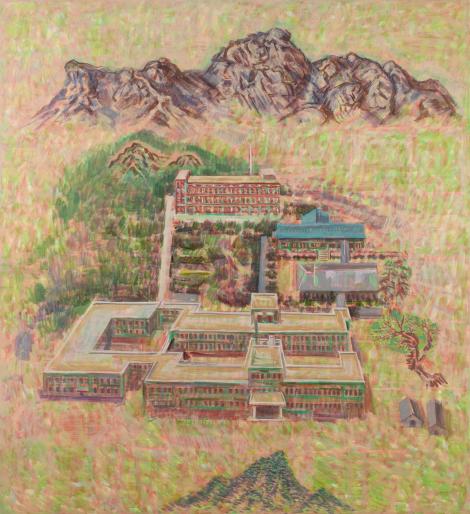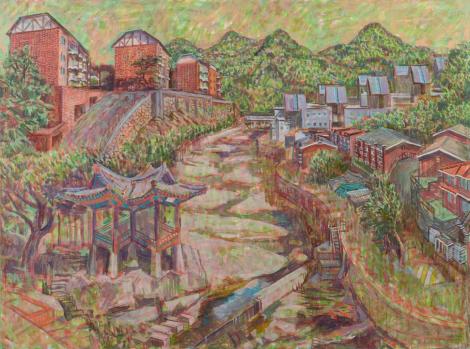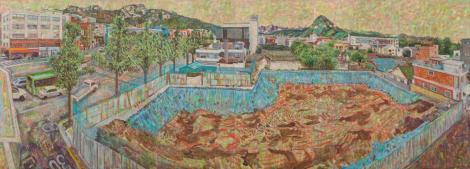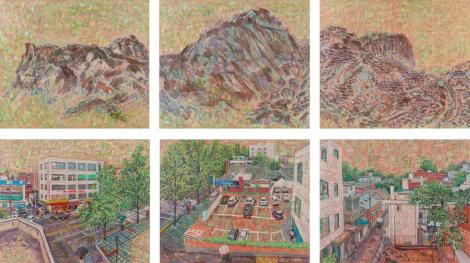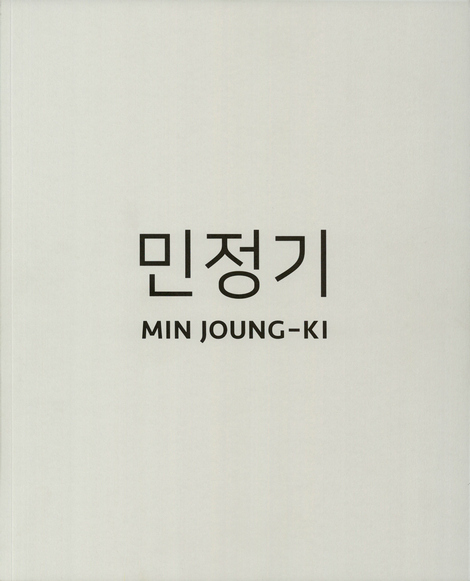 Min Joung-Ki | KUKJE GALLERY
Min Joung-Ki | KUKJE GALLERY
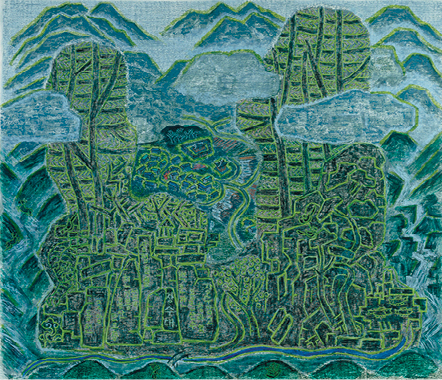
Jan 29, 2019 - Mar 3, 2019
INTRODUCTION
Min is best known for his style of reinterpreting the everyday landscape in a manner that emphasizes its realism and sociopolitical history. While he has focused mainly on geographic features and human traces left on nature, including mountains and water, this exhibition indicates a shift towards urban environments and architecture. In particular, the exhibition will showcase a new group of works that recompose buildings and historic sites around Seoul. This interest is inspired in part by Seoul’s long history; it has been the capital city since the Joseon Dynasty (founded in 1392) and each painting explores some aspect of the city’s history. Specific locations addressed in the new works include well-known sites such as Jongno-gu’s Cheonggye Stream, Sajikdan, Segeomjeong, and Baeksasil Valley. Min also painted urban landscapes in the 1980s, but while his works at that time were mainly composed of arbitrary symbols of urbanism, his Seoul landscapes today are much more complex and specific. These new compositions present labyrinths of engineered spaces and reflect a greater focus on research and social history, interpreted through multiple points of view and competing perspectives.
Born in 1949, Min Joung-Ki gained recognition in the early 1980s with what the artist refers to as his “barbershop paintings.” These paintings affectionately appropriated the unsophisticated, kitschy paintings that frequently adorned barbershops around Korea. In this way, Min consciously employed an anti-aesthetic in order to challenge the conventional values at the time that were supported by official institutions such as Kukjeon (Korean National Art Exhibitions). Min’s “barbershop paintings” were created using oil paint, which at the time was considered an elitist medium. In using oil paint to render these everyday genre paintings, Min was able to foreground his critique of elite tropes of art. In so doing, he championed a genre of the everyday as a tool through which to communicate sentiments and truths that the public could sympathize with.
It is for such reasons that individuality, independence, and placeness were accentuated as significant traits of Min’s work. In particular, Min achieves independence of his art by not merely representing the object but by activating the painting as a means of communication between the past and the present. The artist’s unique style of appropriating traditional Oriental paintings and ancient maps also stems from this interest in engaging with the past. This approach allows Min to avoid nostalgia; instead, he is able to “portray the landscape of today through the remnants of the past.”
Min Joung-Ki accentuates placeness in his paintings, engaging each location’s historicity and capturing each of their geological and geographical features. Since moving his studio in 1987 from Seoul to Yangpyeong, Gyeonggi Province, the artist has concentrated more on mountains and the traces of people who settled in them, often titling the works after the names of specific places, thereby capturing this interest in place and anchoring the paintings in history. As he begins to explore a broader array of subjects such as roads and now architecture, this strategy has remained an essential part of the artist’s practice.
For Min, this approach to painting is based on what he refers to as yinyeon, or a sense of inevitability that leads him to his subjects. It is the roads he has actually walked on, and thus remembers, that he portrays through his diagrammatic paintings. Likewise, he believes that using oil paint and the grammar of Western painting, along with the format of ancient maps, landscapes, and folding screens, are fitting methods for conveying his interest in the intersection of place and time.
In At Leisure in Mongyudowon (2016), Min juxtaposes a contemporary image of Buam-dong with that of the early Joseon period painter An Gyeon’s Dream Journey to the Peach Blossom Land (1447). The painting presents the dramatic contrast between the town’s historic topography captured in historic paintings and its profound transformation today. Sooip-ri (Yangpyeong) (2016) reinterprets the traditional bird’s-eye view and perspective of Oriental paintings as it portrays the present status of the region’s mountains and rivers in the manner of folk paintings. Composed of three and six separate canvases respectively, View of Sajikdan at a Distance (2019) and Inwangsan (2019) borrow the format of folding screens in an attempt to overcome the inconvenience of painting on a single large screen. Such is an effective method that allows the artist to balance the sites’ geography, history, and narrative all in one frame, via a format familiar with the public.
Visualizing history and investing his paintings with temporality, Min’s work generates a unique synchronicity, wherein the various perspectives and time frames coexist in a single pictorial plane. In these compositions, each of his planes are composed of a specific complementary tone, either green or yellow, enhancing the two-dimensionality of the frame. Inside these two-dimensional planes, however, diverse spatial and temporal layers of the past are deconstructed and recombined through the appropriation of modern buildings and signage—thereby forming an organic link and disregarding any one particular perspective.
One example of this is the major new work Cheongpung Valley 1-2 (2019). In this painting, Min juxtaposes a contemporary view of various housing structures, built on artificially remodeled land, along with the 2,000m2 compound built by Yoon Deok-Young on the side of Inwang Mountain. Designed by Yoon, a bureaucrat of the Great Korean Empire (1897-1910), in an ostentatious French style, the building caught fire and was destructed in the 1970s. Min used extensive research and field trips to reconstruct the temporality of the site, depicting it from two different perspectives. Another new work, titled Park Taewon’s Scenes from Cheonggye Stream 1-3 (2019), is founded on the writer Park Taewon’s novel Scenes from Cheonggye Stream and its description of the transformations around this important body of water that runs through the heart of Seoul. This methodology of painting, aptly referred to as synchronicity, successfully establishes an alternative for constructing rich and unending narratives in contrast to the more linear dichotomous perception of time as seen predominantly in the West.
About the Artist
Min Joung-Ki (b. 1949) studied Western painting and graduated with a BFA from the Department of Painting in the College of Fine Arts, Seoul National University, in 1972. As a member of the “Reality and Utterance Group,” Min’s work responds to the changing social conditions in Korea and their manifestations in urban landscapes and popular culture. In 1987, after moving from Seoul to Yangpyeong, Gyeonggi Province, he began to explore the history of human livelihoods centered on the mountains. Unlike many other artists of his generation who graduated from Seoul National University, Min refused to participate in state-funded National Art Exhibitions, and instead became a founding member of the “Reality and Utterance Group.” This movement rejected the so-called “fine arts” and strove to eliminate the gap between tradition and modernism by endowing contemporary art with “the mundane.” After a series of group exhibitions in the 1970s and 1980s including the Exhibitions of December, Exhibitions of the Third Group and Reality and Utterance Group Members’ Exhibitions, Min held his first solo exhibition in 1983 at the Seoul Art Center, followed by solo exhibitions at major Korean institutions such as the Marronnier Art Center (now Arko Art Center) (2004), Chosunilbo Museum of Art (2007), and Kumho Museum of Art (2016). Major group exhibitions include Ilmin Museum of Art (1999), Seoul Museum of History (2013), the 8th SeMA Biennale (2014), Gyeonggi Museum of Modern Art (2016), and Insa Art Center (2016). In 2006, he was awarded the 18th Lee Joong-Sup Award.
국제갤러리는 1월 29일(화)부터 3월 3일(일)까지 2019년 첫 번째 전시로 민정기의 개인전 《Min Joung-Ki》를 개최한다. 국제갤러리에서 처음 선보이는 이번 개인전에서는 40여 년 이상을 회화의 영역에서 풍경을 소재로 한 다양한 관점들을 다뤄 온 작가의 예술 여정을 집약적으로 보여주는 구작 21점과 신작 14점을 소개할 예정이다.
민정기는 주변에서 흔히 볼 수 있는 풍경을 현실적이면서도 인문적인 성찰의 결과로 재해석하는 작업 스타일을 구축해왔다. 그간 산세, 물세 같은 지형적 요소와 그 안에 어우러진 인간의 흔적을 중점적으로 다루었던 데 반해, 이번 전시에서는 그의 관심이 최근 자연에서 도심으로 옮겨간 것을 확인할 수 있다. 특히 조선시대 이후 수도였던 서울 시내에 산재한 건축물이나 터를 역사적 사실에 기반해 재구성하는 작품들을 새로 선보일 예정인데, 종로구에 위치한 청계천, 사직단, 세검정, 백사실계곡 등의 장소가 이러한 신작에서 주로 다루어진다. 물론 작가는 1980년대에도 도시 풍경을 다룬 바 있다. 그러나 당시의 도시 풍경에는 자의적인 기호들이 주를 이루었다면, 지금의 서울 풍경에는 과거 역사나 현 지리를 포함해 직접 인연을 맺는 필연적인 요소들이 수수께끼처럼 얽혀 있다. 그 장소들이 하나의 고정된 관점에서 제시되는 대신 두 가지 이상의 관점에서 다양하게 해석된다는 것도 변화한 점이다.
1949년생인 민정기는 1980년대 초 스스로 ‘이발소 그림’이라 지칭하는 작품들로 국내 화단에서 주목 받기 시작했다. 1970년대에 국전을 중심으로 추대되던 순수미술 또는 추상미술에 대한 반(反)미학적인 공격에 근간을 두었는데, 예컨대 이발소에 걸려 있던 상투적이며 키치(kitsch)에 가까운 그림들을 가져다가 고급 재료로 여겨지는 유화 물감으로 정성스럽게 모사한 작품도 있었다. 이 ‘정성스러운 모사’에는 작가의 분명한 의도가 깃들여 있었다. 미술이 대중들에게 다가가기 힘든 심미적 대상이기보다 일상의 언어처럼 대중이 공감하는 정서나 진실을 소통하기 위한 도구 역할을 해야 한다는 철학이었다.
이런 이유로 민정기 작품에서는 개별성에서 진화한 ‘독립성’과 풍경화가로서 담보한 ‘장소성’이 중요한 특징들로 꼽힌다. 민정기 작품의 독립성은 대상의 단순한 재현을 통해서가 아니라 그것이 과거와 현재를 잇는 도구 역할을 함으로써 얻어졌다. 민정기의 작품에 등장하는 전통 동양화나 고지도를 차용하는 고유한 화풍도 이러한 소통의 강조를 전제한다. 이는 “예전 것들을 통해서 오늘날의 모습을 그린다”는 의도를 반영하며, 따라서 과거를 향한 회고나 노스탤지어(nostalgia)와는 거리가 멀다.
한편 ‘장소성’은 해당 장소의 지형적, 지리적, 인문학적 지식이나 역사성에 주목하여 그 장소만의 독자적인 측면을 부각시키는 작가의 방식에서 비롯되었다. 지난 1987년 서울에서 경기도 양평으로 스튜디오를 이전한 이후 작가는 산과 그 안에 터를 내린 사람의 흔적을 더욱 집중적으로 다루었는데, 지명이나 고유명사로 이루어진 작품 제목들은 그의 이러한 관심을 단적으로 보여주는 좋은 예다. 그리고 최근에는 산세뿐만 아니라 강물과 도로, 나아가 도심의 공간에 이르기까지 관심 범위가 더욱 확장되고 있다.
민정기에게 작업은 스스로 ‘인연’이라 칭하는 작품과 본인 사이에 존재하는 일종의 필연성을 확인하는 과정이다. 답사와 연구를 바탕으로 몸소 다녀봐서 기억하고 있는 길들을 도해적 연결이나 지리적 배치를 통해 보여주기 때문이다. 이때 앞서 언급한 것과 같이 유화 물감과 서양의 조형어법을 통해 고지도나 산수화, 병풍 등의 방식을 차용하여 재해석하고 있음을 확인할 수 있는데, 이 같은 과거의 방식들이 그림을 통해 전달하고자 하는 내용이나 주제에 적합하고 유용하다고 판단했기 때문이다.
예를 들어, 이번 전시에서 선보일 <유 몽유도원>(2016)은 조선 초기 안견의 몽유도원도 이미지 위에 현재의 부암동 풍경을 병치시킴으로써 부암동의 태곳적 지세와 변모된 현실풍경을 극명하게 대비해 보여준다. <수입리(양평)>(2016)은 동양화에서 흔히 볼 수 있던 전통적인 부감법과 투시도법을 재해석하며 산과 강의 현재적 상황을 민화적으로 풀어낸다. 또한 각각 3매와 6매로 구성된 연작 <사직단이 보이는 풍경>(2019)이나 <인왕산>(2019)은 큰 화면을 그릴 때 감수해야 하는 불편함을 극복하고자 익숙한 병풍의 형식에 착안, 여러 개로 나누어진 화폭으로 구성한 작품이다. 대중에게 익숙한 형식을 통해 지역의 지형적 정보, 역사적 지식, 서사성 등을 모두 한 화폭에 아울러 담고자 연구한 결과물이다.
역사를 시각화하여 평면회화에 시간성을 부여하는 민정기의 작업은 결과적으로 한 화면에 다양한 시점과 시간의 공존, 즉 공시성(synchronicity)을 야기한다. 그의 화면은 녹색 계열 또는 황색 계열의 통일된 색감으로 구성되어 마치 2차원적 화면의 평면성을 부각시키는 듯 보인다. 그러나 그 안에는 현대식 건물이나 간판이 과거로부터의 다양한 공간적, 시간적 층위들과 함께 해체된 후 재조합된 것처럼 원근법을 무시한 채 자연스레 연결되어 있다.
일례로 신작인 <청풍계 1~2>(2019)는 대한제국의 관료였던 윤덕영이라는 인물이 일제강점기에 인왕산 자락에 지은 600평 규모의 프랑스식 건물을 예전의 지형을 바꾸고 가파르게 들어선 다세대 주택들과 병치하여 보여준다. 그러나 정작 윤덕영은 그 집에 입주도 못한 채 운명하였으며 그 후 건물은 여러 쓰임새로 사용되다가 화재로 소실되어 결국 1970년대에 철거되었다. 작가는 이와 관련된 사료 연구와 답사를 통해 장소에 내재된 시간성을 복구, 두 가지 다른 각도에서 본 화면들로 재구성했다. 또 다른 신작 <박태원의 천변풍경 1~3>(2019)은 박태원의 소설 『천변풍경』을 바탕으로 청계천의 변모한 모습을 생활 속으로 가져와 담은 작품이다. 민정기가 선택한 공시성의 방식은 ‘집단적 기억’ 같은, 애초에 통합될 수 없는 대상의 성질을 표현하는 데 가장 적합한 방식이자 서구의 이분법적이고 선형적인 시간 인식에 대응하여 보다 풍부한 서사를 구성하는 훌륭한 대안이 된다.
작가 소개
민정기(b. 1949)는 서울대학교 미술대학 회화과에서 서양화를 전공했다. 서울이라는 도시와 대중적 일상 속에서 문화장치에 민감하게 반응, 이를 다양한 형식으로 표현하며 독자적인 작업 스타일을 구축해온 작가는 지난 1987년 서울에서 경기도 양평으로 이주한 후 본격적으로 산을 중심으로 한 우리 삶의 터전과 역사를 다루기 시작하였다. 민정기는 다른 서울대학교 출신 작가들처럼 국가가 지원하는 국전에 참여하는 대신 1980년부터 ‘현실과 발언’ 동인의 창립 멤버로 활동하면서, 소위 고급예술이나 순수미술을 거부하고 현대미술에 ‘상투성’을 부여함으로써 전통과 모더니즘의 간극을 해소하고자 시도하였다. 1970년대에 《12월전》, 《제3그룹전》, 1980년대에 《현실과 발언 동인전》 등의 단체전 활동을 이어오던 작가는 1983년 서울미술관에서의 첫 개인전을 시작으로 문예진흥원 마로니에 미술관(2004), 조선일보미술관(2007), 금호미술관(2016) 등 국내 주요 기관에서 개인전을 개최하였다. 주요 단체전으로는 일민미술관(1999), 서울역사박물관(2013), 제8회 SeMA 비엔날레(2014), 경기도미술관(2016), 인사아트센터(2016) 전시 등이 있다. 지난 2006년에는 제18회 이중섭 미술상을 수상한 바 있다.
WORKS
|
둥지봉에서 본 옥순봉 |
묵안리 장수대 |
|
|
금사면 이포나루 |
고지도에 얹은 신단양 |
|
|
여주 이포나루 |
토교 우리촌 |
|
|
세검정 주변 풍광 |
유 몽유도원 |
|
|
청풍계 2 |
명당도 1 |
|
|
명당도 2 |
세검정 |
|
|
인왕산, 보현봉, 백악산이 보이는 풍경 |
인왕산 |
|
INSTALLATIONS
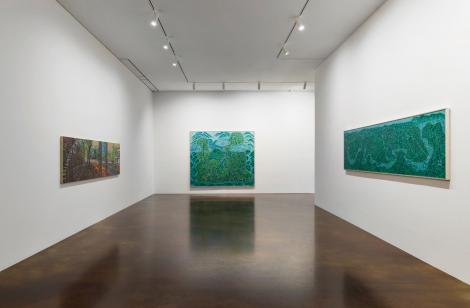
|
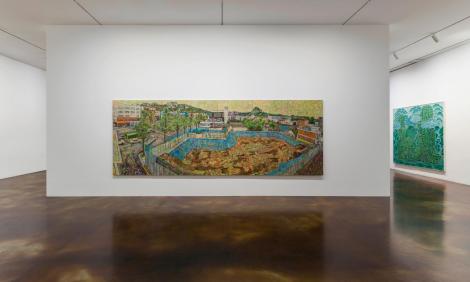
|
|
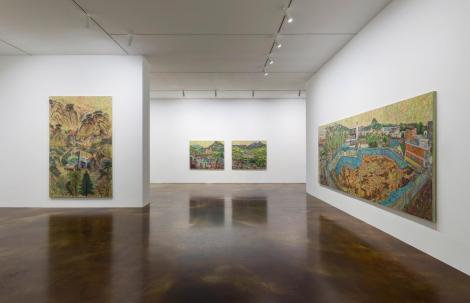
|

|
|
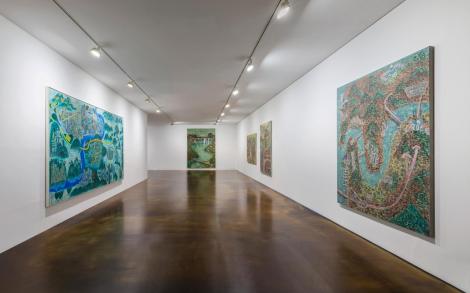
|
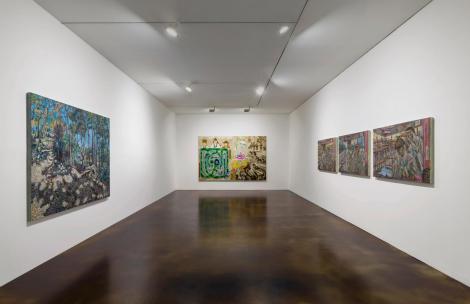
|
|
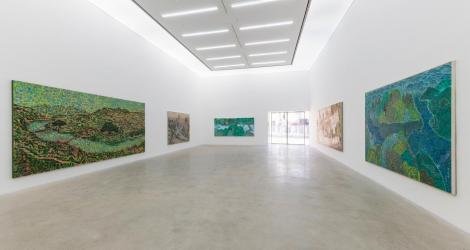
|

|
|
VIDEOS
|
Installation Video |
Teaser Trailer |
|
PUBLICATIONS
| Min Joung-Ki |
MEDIA COVERAGE
일간지
월간지
주간지/웹
방송
